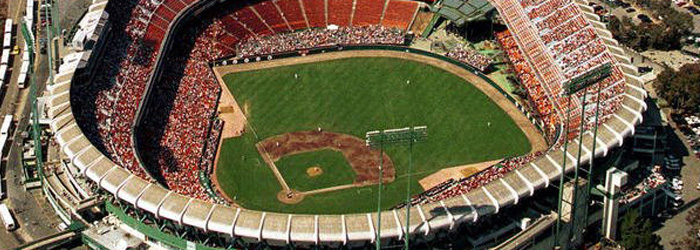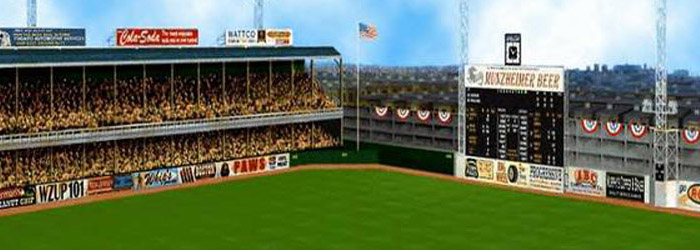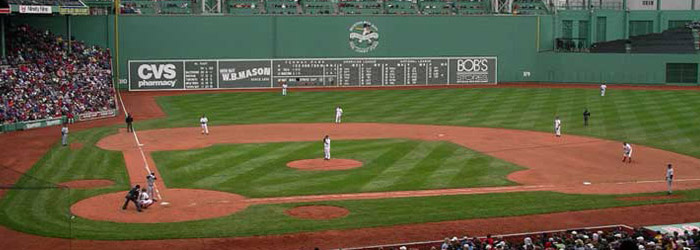









The concept of most valuable player awards dates back more than a century. The first documented MVP-type honor in pro ball was bestowed upon James "Deacon" White of the 1875 Boston Red Stockings in the National Association. Catcher White sparked Boston to a remarkable 71-8 record that year, scoring 77 runs in 80 games and batting .355. An ardent Red Stockings admirer presented Deacon with a silver tray, water pitcher, and loving cup inscribed with the words: "WON BY JIM WHITE AS MOST VALUABLE PLAYER TO BOSTON TEAM, 1875."
The first official MVP honor was initiated some 35 years later. Prior to the 1910 season, baseball fan Hugh Chalmers, president and general manager of the Chalmers Motor Company, announced that he would present one of his company's automobiles-a Chalmers "30"-to the major league player who compiled the highest batting average. What appeared to be a harmless promotional gimmick soon turned into a public relations disaster.
The rules specified that players must accumulate a specific minimum number of times at bat, depending on position, to qualify for the award. For infielders and outfielders, it was a minimum of 350 at bats; for catchers, 250 at bats; and for pitchers, 100 at bats. Interest in the award was tremendous from the outset. Ty Cobb, who already owned a Chalmers "30" roadster, wrote: "I am glad that something besides medals and trophies is offered for the championship in batting. I think the offer of a Chalmers "30" is simply great and I hope to be lucky enough to own a new Chalmers next fall."
It developed into a two-man race, with Detroit's Cobb and Cleveland's Napoleon Lajoie, both American Leaguers, the only serious challengers for the coveted prize. Throughout the season charges and countercharges accused scorers in various cities of favoritism. The general consensus of the press was that Cobb's selfish pursuit of this individual honor had cost his team the pennant. The controversy was capped by scandalous circumstances on the final day of the season.
Until September 16, Cobb held a solid lead over Lajoie,.368 to .357. (Although because of the era's sloppy record keeping, few actually knew the official figures at the time.) Between then and October 8, Cobb batted a torrid .532 (25-for-47) to seemingly lock up the crown with a .383 average. But Lajoie refused to surrender, going 30-for-54 (.556) in that same span to enter the final day, October 9, with a .376 mark. Cobb chose to sit out his final game, while Lajoie played the infamous doubleheader with the St. Louis Browns in which he went eight-for-eight, including seven bunt hits-remarkable for a slow-footed slugger-to apparently edge out Cobb in the batting race.
Browns Manager Jack O'Connor had instructed his rookie third baseman, Red Corriden, to play deep on Lajoie, and Corriden complied. Lajoie took advantage of the strange defensive arrangement with the repeated safe bunts. Although neither Lajoie nor Corriden was implicated, there were charges of a Browns frame-up to give the coveted batting title (and car) to the respected Lajoie rather than the unpopular Cobb.
O'Connor lost his job due to his role in the alleged fix. Subsequently, AL President Ban Johnson announced that a "discrepancy" had been found in the official records and that Cobb had actually won the batting crown after all. (Although this point is challenged by many current researchers, who have evidence that Cobb was credited wrongly for a two-for-three game.) Meanwhile, Hugh Chalmers, attempting to divorce himself from the controversy, presented autos to both Cobb and Lajoie. It was generally acknowledged that this fiasco doomed the future of individual awards of any kind.
Hoping to salvage some goodwill out of the whole idea, Chalmers came up with a new proposal for the1911 season. This time he would award an auto to one player in each league who "should prove himself as the most important and useful player to his club and to the league at large in point of deportment and value of services rendered." The decision for this honor was to be made by a committee of baseball writers, one writer from each club city in each league. Each writer was to make eight selections, with a first-place ballot scoring eight points down to an eighth-place vote scoring one point. The short-lived Chalmers Award was born, with Ty Cobb and Frank Schulte earning recognition in1911. Both Cobb and Schulte voluntarily withdrew from the competition in 1912, although Cobb received 17 points anyway.
Interest in the award diminished within a few years. By 1914 the public was distracted by Organized Baseball's battles with the new Federal League and the escalation of World War I in Europe. The timing was right for the Chalmers Award to quietly disappear. Mr. Chalmers had agreed to present vehicles for five years, and the 1914 awards marked the fifth and final presentation.
On July 15, 1922, the newly formed American League Trophy Committee adopted a set of rules governing the selection of an annual award-winner. The rules specified that "the purpose of the American League Trophy is to honor the baseball player who is of greatest all-round service to his club and credit to the sport during each season; to recognize and reward uncommon skill and ability when exercised by a player for the best interests of his team, and to perpetuate his memory." The rules further instructed voters to seek out the "winning ball player," reminding them that "combined offensive and defensive ability is not always indicated by any system of records."
Eight baseball writers, one from each AL city, were enfranchised, with each required to select exactly one player from each team, for a total of eight selections. Player-managers and previous winners were to be excluded from consideration. Points were distributed the same as in the Chalmers Award: eight for first place, down to one for eighth.
The intention of AL President Ban Johnson was to have a monument to Baseball erected in East Potomac Park, Washington, D.C., engraved with the names of winners of the AL Award. This proposal was introduced as a congressional resolution in 1924 and passed in the House of Representatives before dying on the Senate Floor.
The AL voting rules led to growing criticism for several reasons, one of which was the limitation on the number of vote-getters from each team. For example, when the Browns' George Sisler won the first AL Award in 1922, he was named on all eight ballots- disqualifying his teammates from receiving any votes. As a result, fellow Brownie Ken Williams, who led the league in home runs (39), RBIs (155), and total bases (367) and became the first player ever to have 30 homers and 30 stolen bases in the same season, was shut out in the League Award voting.
Then the rule prohibiting player-managers from eligibility drew fire. In 1925, when this rule eliminated five solid candidates from consideration, The New York Times wrote, "to say that it is impossible or impractical to divorce a man's managerial skill from his talents purely as a player is to reflect on the intelligence of the committee that awards the prize."
The Times further editorialized on the fallacy of assuming that no player can be the "most valuable" more than one year: "the purpose, of course, is to pass the honor around, but the effect is to pass an empty honor around." This rule became increasingly ridiculous when it eliminated Babe Ruth (and his 60 home runs) from consideration in1927. By the following year, both Ruth and teammate Lou Gehrig, who were in the process of finishing one-two in the AL home run derby in five consecutive seasons, were ineligible for the League Award.
In 1924 the National League instituted its own award, with radical differences in the selection method. Each writer voted for 10 players rather than 8 (10 points for first place, and so on); each was not bound to vote for a certain number of players from each team; each was free to select a player-manager; and, later, each one was allowed to consider previous winners of the award. Additionally, the NL offered a cash "present" of $1,000 to the award-winner.
At various times between 1925 and 1951, writers were permitted to name "honorable mention" candidates whose vote totals were listed but not counted in the balloting. Another feature of early voting reports was the listing of "cumulative vote leaders"-a forerunner to Bill James's "award shares"-for a period of years.
A number of factors led to the demise of the AL Award, including the award's loss of credibility due to the previously mentioned shortsighted voting rules. Secondly, Ban Johnson, having failed to secure the erection of his proposed monument, felt the award had fallen short of its aim. Finally, management was concerned with the efforts of award-winners to parlay their honors into substantial pay raises. The AL Award was officially voted out at a special league meeting on May 6, 1929.
The National League followed suit with the AL's decision but agreed to continue offering its award through the 1929 season.
In October 1929 the Baseball Writers Association of America (BBWAA) announced the results of an "unofficial" AL most valuable player poll whose winner was Lew Fonseca of Cleveland. Two months later, The Sporting News conducted a poll of the eight writers who had previously voted on the League Award, thereby reporting Al Simmons as the "unofficial" AL Award-winner. Combining the results of these two unofficial polls gives Fonseca 77 points, followed by Heinie Manush (57), Simmons (56), Tony Lazzeri (55), and Charlie Gehringer (44).
The Sporting News announced that, thereafter, they would take it upon themselves to conduct an annual poll to substitute for the defunct league awards. However, the News retained the stipulation that each voter must select just one player on each team. In 1930, The Sporting News chose Joe Cronin in the AL and Bill Terry in the NL. Earlier, the Associated Press also put together a special committee of writers to make an unofficial AL selection for 1930, while the BBWAA did the same for the NL (adding a check for $1,000 for the winner). The respective selections were Cronin in the AL and Hack Wilson in the NL. Again combining the two sets of polls, the AL leaders were Cronin (100), Al Simmons (85), Lou Gehrig (68), Charlie Gehringer (67), and Ted Lyons (56). The NL pace-setters were Hack Wilson (111), Frankie Frisch (107), Bill Terry (105), Chuck Klein (57), and Floyd "Babe" Herman (52).
In an effort to standardize MVP voting, the BBWAA, in its annual winter meeting in New York on December 11, 1930, decided to appoint two committees (one in each league) to elect most valuable players, with the association to "award suitable emblems to the players selected." The modern MVP Award was born, with most of the flaws of its forerunners eliminated.
The Sporting News, however, continued to make its own selections in bitter competition with the BBWAA. Finally, beginning in1938, The Sporting News agreed to unify the award by abiding with BBWAA balloting, and presenting The Sporting News Trophy to the winner. Among the various prizes awarded to the winners were wristwatches and shotguns.
At a meeting during the 1944 World Series, the BBWAA decided to begin issuing its own trophy, the Kenesaw Mountain Landis Award, in honor of the ailing Commissioner. Landis died a month later, and the official MVP Award has born his name ever since. A plaque engraved with the names of the winners hangs in the National Baseball Library in Cooperstown, New York.
The Sporting News went back to naming its own MVPs in 1944 and1945. Then, at the request of the new commissioner, Happy Chandler, The Sporting News "withdrew from the field to cooperate in making the Landis Awards, provided by the major leagues, the official designations of the year." In 1948, however, The Sporting News went back to its own awards, selecting a Player of the Year and Pitcher of the Year in each league, as they have done ever since. For some reason, The Sporting News awards have never received the public recognition of the BBWAA honors.
Two major changes in the MVP voting began in 1938. The BBWAA began polling three writers, instead of one, in each major league city, which remained in effect until it was reduced to two writers per city in 1961. Also in 1938 the process was initiated to award 14 points for each first-place vote, rather than 10.
"Split votes," which have since infiltrated all the major awards, first appeared in MVP Awards in 1959. The American League MVP race that year, by consensus, was between second baseman Nellie Fox and shortstop Luis Aparicio of the champion Chicago White Sox . Late in the season, the suggestion often arose that the two should share the award. When the votes were in, Fox had received 14 first-place votes, Aparicio had received 6, and four writers had split their votes between the two. Tickled with the idea of a split vote, one NL writer also resorted to this option, dividing his first-place nomination between Ernie Banks and Ed Mathews . The cop-out vote, having been allowed in 1959, has since surfaced in 16 more MVP Awards, 10 Rookie of the Year Awards, and six Cy Young Award elections. The ultimate folly of this practice was best exemplified in 1979. One NL writer split his fourth-place vote between pitching brothers Phil and Joe Niekro, evidently convinced that the two were identical twins. But the writer was still permitted to make six more selections. That meant that his fifth-, sixth-, and seventh-place selections received more points (six, five, and four, respectively) than his fourth-place co-selections, who were credited with just three and a half points apiece.
There has long been debate about the consideration of pitchers for the MVP Award. It has been suggested that a man who plays every fourth game cannot be as valuable as a man who plays every day. The debate escalated after the inception of the Cy Young Award in 1956, giving pitchers their own exclusive honor, and the increasing practice of five-man rotations in the 1970s, giving starting pitchers even less of a chance to contribute. As far as Jack Lang, executive secretary of the BBWAA, is concerned, there is no room for controversy. "The rules that are sent out to the voters on the (MVP) committee state: 'Keep in mind that all players are eligible. That includes pitchers, starters and relievers,'" says Lang. "Anybody on the committee that feels they cannot vote for a pitcher, we replace them. In my 24 years running the elections, only two writers have said that to me." Since 1931, pitchers have won the award 10 times in the AL and 9 times in the NL.
On 14 occasions one player received all of the available first-place MVP votes in his league. The AL players so honored are Ty Cobb (1911), Babe Ruth (1923), Hank Greenberg (1935), Al Rosen (1953), Mickey Mantle (1956), Frank Robinson (1966), Denny McLain (1968), Reggie Jackson (1973), and Jose Canseco (1988). The four unanimous NL selections are Carl Hubbell (1936), Orlando Cepeda (1967), Mike Schmidt (1980), and Jeff Bagwell (1994). Hubbell's distinction is disputable, as two of the eight writers did not submit ballots that year and were not replaced on the selection committee.
Upon numerous occasions the MVP vote point totals did not add up to the correct figure. Reasons for this include inaccuracies in tabulation, inaccuracies in reporting, and writers who failed to vote or to complete their ballots. However, the total impact of all these errors is a small fraction of 1 percent of the total voting over the years.